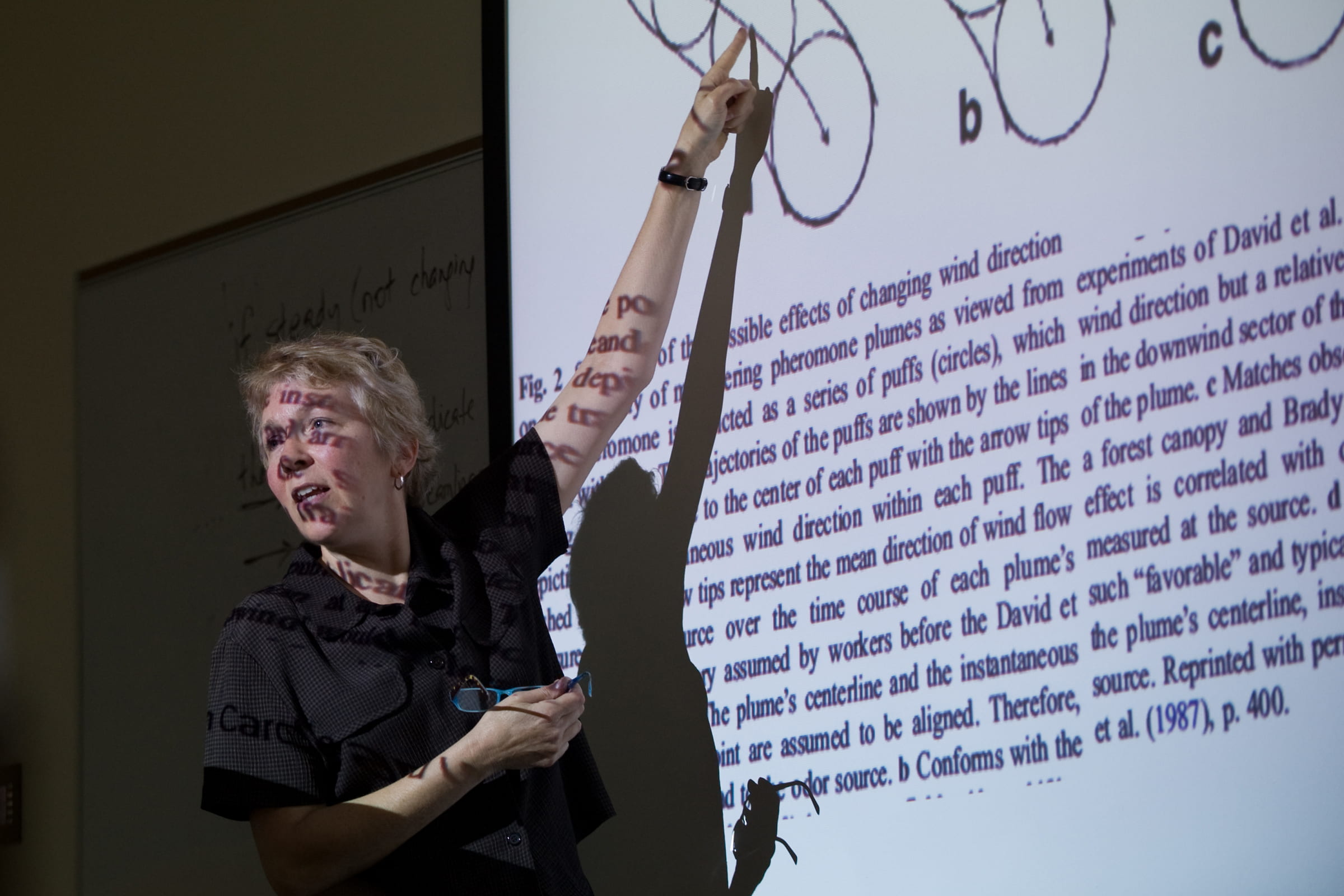Going with the flow
Innovative biology course makes the unseen – and its movement – visible.

It begins as a typical late-in-the- quarter class. After a quiz that leaves students with furrowed brows or vacant stares, ecology & evolutionary biology lecturer Catherine Loudon stands at the board, holding forth on diagrams related to flow visualization and imaging.
But half an hour later, she and two dozen biology majors are ankle deep in the foliage beside Steinhaus Hall, blowing bubbles and videotaping their motion.
“Sticky!” exclaims senior Robert Jones, one of the “sources” assigned to blow a steady stream of the delicate, viscous orbs outward in a simulation of a female insect releasing mating pheromones.
A light breeze riffles the air. Students designated as potential mates fan out in a precise 360-degree circle around Jones and three other sources. The lucky ones take a step forward or sideways each time a bubble lands on their shoulder, pant leg or shoe, depending on the angle of its approach. The erratic, windblown patterns of insect life quickly emerge.
“So the meaning of the phrase ‘flow visualization’ should now be self-evident,” Loudon says. “We’re making it possible to see things that are normally invisible.”
It’s all part of an upper-level undergraduate laboratory course, “Image Analysis in Biological Research,” formally offered for the first time this spring.
The students make movies and other images of biological processes in the small, hands-on class. They use high-end cameras for thermal videography, super-high-speed video and time-lapse photography. But just as often, they’re outside on campus with inexpensive cameras, mapping the motion of paper airplanes to help visualize the flow of air around insect bodies.
“This is the YouTube generation,” Loudon notes.
“It’s much better to do labs with applications to the real world,” says senior Christopher Sobowale of Los Angeles, who plans to become a radiologist. He adds that the paper airplane exercise was particularly helpful, teaching him how to calculate the velocity and fluctuation of a moving object and create an accurate image, often far different from a computer-generated model.
Loudon strives to keep her in-class lectures relevant, using newspaper articles and timely websites showing models of BP oil spill plumes and the mixing, dispersion and transport across the Pacific Ocean of radioactive material from Japan’s earthquake- and tsunami-stricken nuclear power plants. Tornadoes are thrown in for good measure as a graphic example of how invisible winds can become apparent.
But nothing works like good, clean fun with soap bubbles on a breezy day. Some of the student videographers shoot from a balcony above, like paparazzi. Loudon even has designated wind generators – class members equipped with file folders and plastic bin lids who fan their implements vigorously when the breeze dies.
The students will use a free online program to digitize, edit and compose video clips of the bubble trails the following week. They have previously diagrammed the gaits of bobbing giraffes and penguins, as well as waddling ducks and loping tigers.
“This is a neat example of a course that could be found in very few places, particularly at the undergrad level,” says Brandon Gaut, chair of the Department of Ecology & Evolutionary Biology. “We’re lucky to have a dedicated teacher like Kate to implement it.”
Students agree.
“It actually makes concepts tangible for us, as opposed to just using PowerPoint. It makes me want to come to class,” says Don Balanay, a graduating senior from Pico Rivera. The exercises may be fun, but the motivation is serious: After watching his father suffer from kidney failure, Balanay hopes to go to medical school, and knowing how to prepare and read MRIs and X-rays is critical. “This course really expands my spectrum of knowledge about medical imaging,” he says.
A mechanic for six years, senior Scott Anderson of Orange has always been interested in how individual parts come together to make something work. After realizing the human body is an even better example of this than cars, he decided to become a surgeon. Loudon’s class is a favorite. “This is my fourth year of sitting through these 300-people lectures where nobody knows my name,” Anderson says. “Here, she’s teaching me how to do something and apply it.”
“It’s really nice to do a small class,” Loudon allows. “I’ve taught human physiology and introductory biology to 1,700 students this year. I’m finally getting a chance to learn some names.”
With that, she turns back to the course at hand. “OK, awesome! Photographers ready? Potential mates ready?” she shouts into the wind. “GO!”





